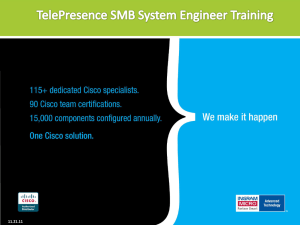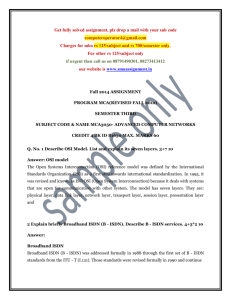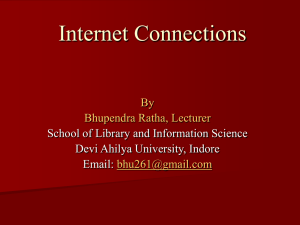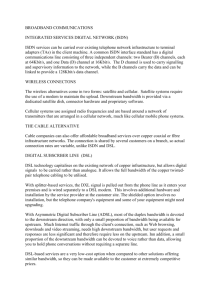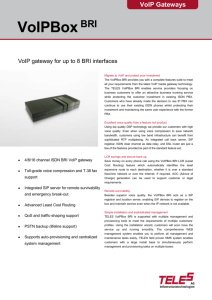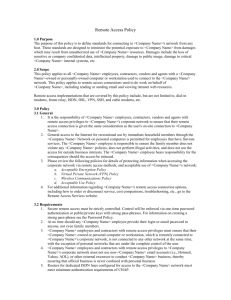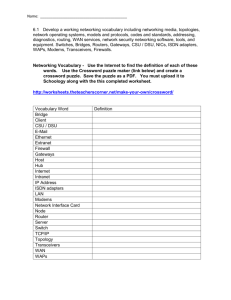Assigment
advertisement
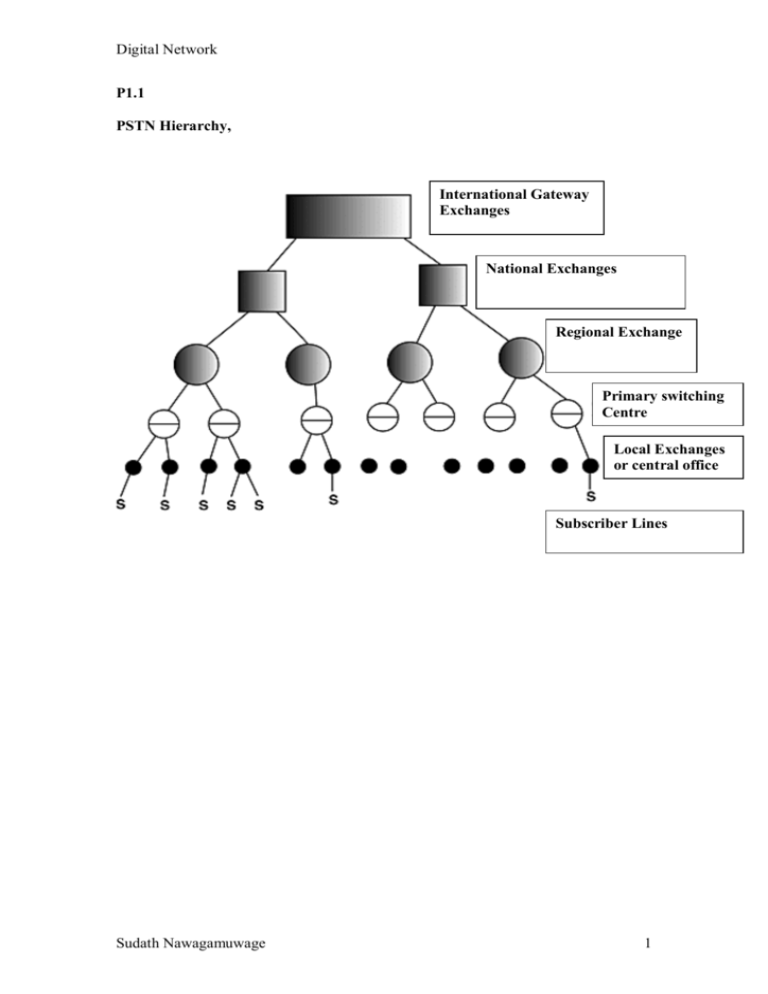
Digital Network P1.1 PSTN Hierarchy, International Gateway Exchanges National Exchanges Regional Exchange Primary switching Centre Local Exchanges or central office Subscriber Lines Sudath Nawagamuwage 1 Digital Network P1.2 A ISDN Services There are two main services associated with ISDN – Basic Rate Interface (BRI) and Primary Rate Interface (PRI). Both services consist of multiple channels over which data can be sent (known as B channels) and also include a signaling channel (the D channel). The D channel is used for control and signaling purposes, such as setting and tearing down ISDN call. Referred to as “out-of-band” signaling, this method ensures that other ISDN calls do not interfere with existing connections, that bandwidth on the B channels is reserved for data only, and ultimately results in quicker call setup and teardown. There are two types of services associated with ISDN: • BRI • PRI Basic Rate Interface (BRI) ISDN Basic Rate Interface ISDN is made up of two 64 Kbps B channels that are used for sending and receiving data in full duplex, and one 16K D channel for signalling. In total, an ISDN BRI interface provides 144K of bandwidth (64+64+16). ISDN BRI is often referred to as 2B+D. Many Cisco router models include built-in BRI interfaces, but they can also be added using modular WAN interface cards. Primary Rate Interface (PRI) ISDN For companies with higher bandwidth requirements, ISDN Primary Rate Interface (PRI) service exists. In North America, PRI service consists of 23 64 Kbps B channels, and one 64Kbps D channel, for a total possible bandwidth of 1.544Mbps (T1 equivalent). In Europe, PRI service consists of 30 B channels and 1 D channel, for a total bandwidth of 2.048Mbps (E1 equivalent). ISDN PRI interfaces are Sudath Nawagamuwage 2 Digital Network typically implemented as modular WAN interfaces on Cisco routers, although some models do include built-in PRI ports Videoconferencing Videoconference (also known as a video teleconference) is a set of interactive telecommunication technologies which allow two or more locations to interact via two-way video and audio transmissions simultaneously. It has also been called visual collaboration and is a type of groupware. It differs from videophone in that it is designed to serve a conference rather than individuals. It is capable of communicating with almost all commercially available conferencing systems over ISDN lines (digital telephone lines). It can also be used for conferencing over the Internet but this is much less reliable. High speed file transfer High speed file transfer the high bit rate speeds of ISDN make file transfer application a snap. Performance, The use of ISDN to connect LANs and enable remote access to LANs and LAN based services is feasible and offers bit rates to users of up to 128 kbps, which is adequate for many sorts of computer based 'multimedia' sessions. ISDN is seen by many in the industry as the ramp through which multimedia networking will gain acceptance. The installed base of ISDN is growing rapidly (30,000 line per month in Germany). ISDN is able to provide connections throughout the world. In Europe there are 'Euro-ISDN' agreements between operators. In the USA the use of the Web is driving the growth of ISDN in some states. Internet Access We support unlimited access using dual channel, bonding on ISDN lines - giving 128kbps BOTH upstream and downstream, with fast call connect times, all the features of the Standard Dial-up account and usage without caps. When our Sudath Nawagamuwage 3 Digital Network broadband offering becomes available in your area you can move to it while keeping your email and website addresses. Remote Backup Remote Backup is the process of transmitting your files, via a network connection, to a geographically remote location where they can be stored safely for later retrieval. Remote Backup addresses both the execution and physical security concerns of a company wishing to prevent data loss. Since the process is entirely network-based, the scope for human error remote backup could be done via ISDN or using faster fixed-line connections, but the cost was prohibitive, both for potential service providers, and for many potential customers. LAN to LAN connectivity LAN-LAN interface policy is specified at the boundary between sub-networks which are in the same geographic location Sudath Nawagamuwage 4 Digital Network P1.2 B ISDN reference points R,S,T,U AND V R A communication reference point between a non-ISDN compatible TE and a TA. S A communication reference link between the TE or TA and the NT equipment. T A communication reference point between user switching equipment and a Local Loop Terminator. U A communication reference point between the NT equipment and the LE. This reference point may be referred to as the network boundary when the FCC definition of the Network terminal is used. V The interface point in an ISDN environment between the line termination and the exchange termination. The functional grouping of ISDN is Network termination 1 (NT1), Network termination 2 (NT2) and terminal equipments. TE1: Specialized ISDN terminals are referred to as terminal equipment type 1 (TE1). Ex. Digital telephone, Integrated voice/data terminals and digital facsimile equipment. Or whatever it is that we hook up to the ISDN phone line. TE2: Non - ISDN terminals such as DTE that predate the ISDN standards are referred to as terminal equipment type 2 (TE2). Ex. Terminal with physical interface as RS232 and host computers with X.25 interface. This is the old analog telephone. Or oldstyle fax machine. Or modem. Or whatever we use to hook up to the analog phone line. It can also be other communications equipment that is handled by a TA. Sudath Nawagamuwage 5 Digital Network TA: Terminal Adaptor. This lets old, TE2 stuff talk to the ISDN network. It also adapts other kinds of equipment, like ethernet interfaces , to ISDN. NT1: Network Termination type 1. This is the end of the line for the local phone company, and the beginning of your house's phone network. Network termination 1 (NT1) belongs to OSI layer1, functions associated with physical and electrical termination of the ISDN on the user’s premises. NT2: Network Termination type 2. In most homes, this won't exist. Network termination 2 (NT2) belongs to layer2 & 3 of OSI layer which is an intelligent device, functions as switching and concentration functions. For a big company with private telephone system, this would be the guts of that telephone system. LT: Line Termination. This is the physical connection to the phone company. ET: Exchange Termination. This is the local phone company's logical connection from your telephones to "the phone network". Figure 1.1 Sample ISDN Configuration Illustrates Relationships Between Devices and Reference Points, Figure 1.1 Sudath Nawagamuwage 6 Digital Network P1.3 A Oregon, USA. Found Using: http://www.kropla.com/dialcode.htm http://decoder.americom.com/decoderscript?handle=101&Search=503 P1.3 B Group 2: The numbers is used to identify the country you are calling international exchange. Group 1: The numbers connects you to the 00 1 503 XXX YYYY Group 5: The numbers specifies the phone line that runs from the local exchange into your residence international Group 3: The Numbers is used to specify the geographic region of the country you are calling international exchange. Group 4: The numbers is used to identify the local exchange international exchange. Sudath Nawagamuwage 7 Digital Network This diagram shows that the local number can be divided into an exchange code (end office switch identifier) and a port (or extension) code. P1.3 C Task 2 GoS = A N / N! A 2 A3 A N 1+ A + + + 2! 3! N! A = Traffic (Erlangs). N = Circuits/Paths/Lines. GoS = Grade of Service. Residential: Gos: No greater than 0.02 or 1 in every 50 calls lost. A = 0.6E, N = 1 0.6 1 /1! = 0.6 0.6 = 0.375 1 + 0. 6 Sudath Nawagamuwage 8 Digital Network A = 0.6E, N = 2 0.6 2 /2! = 0.18 0.18 = 0.101 0.6 2 1 + 0.6 + 2! A = 0.6E, N = 3 0.6 3 /3! = 0.036 0.036 = 0.0198 0.6 2 0.6 3 1 + 0.6 + + 2! 3! Traffic Intensity Number of Circuits GoS (Grade of Service) 0.6 E 0.6 E 0.6 E 1 2 3 1 Call Lost in Every 0.375 0.101 0.0198 Industrial: GoS: No greater than 0.05 or 1 in every 20 calls lost. A = 1.5E, N = 1 1.5 1 /1! = 1.5 1.5 = 0.6 1 + 1. 5 A = 1.5E, N =2 1.5 2 /2! = 1.125 1.125 = 0.310 1.5 2 1 + 1.5 + 2! A = 1.5E, N =3 1.5 3 /3! = 0.5625 Sudath Nawagamuwage 9 Digital Network 0.5625 = 0.134 1.5 2 1.5 3 1 + 1.5 + + 2! 3! A = 1.5E, N =4 1.5 4 /4! = 0.211 0.211 = 0.04797 1.5 2 1.5 3 1.5 4 1 + 1.5 + + + 2! 3! 4! Traffic Intensity Number of Circuits GoS (Grade of Service) 1.5 E 1.5 E 1.5 E 1.5 E 1 2 3 4 1 Call Lost in Every 0.6 0.310 0.134 0.04797 A = 0.6E + 1.5E = 2.1E Between Exchange A and B: GoS: No greater than 0.05 or 1 in every 20 calls lost. A = 2.1E, N =1 2.1 1 /1! = 2.1 2. 1 = 0.677 1 + 2. 1 A = 2.1E, N =2 2.1 2 /2! = 2.205 2.205 = 0.416 2.12 1 + 2.1 + 2! A = 2.1E, N =3 2.1 3 /3! = 1.5435 Sudath Nawagamuwage 10 Digital Network 1.5435 = 0.225 2.12 2.13 1 + 2.1 + + 2! 3! A = 2.1E, N =4 2.1 4 /4! = 0.8103375 0.0.8103375 = 0.106 2.12 2.13 2.14 1 + 2.1 + + + 2! 3! 4! A = 2.1E, N =5 2.1 5 /5! = 0.34034175 0.34034175 = 0.04255 2.12 2.13 2.14 2.15 1 + 2.1 + + + + 2! 3! 4! 5! Traffic Intensity Number of Circuits GoS (Grade of Service) 2.1 E 2.1 E 2.1 E 2.1 E 2.1 E 1 2 3 4 5 1 Call Lost in Every 0.677 0.416 0.225 0.106 0.04255 Lists of Reference 1http://www.cisco.com/univercd/cc/td/doc/cisintwk/ito_doc/isdn.htm#wp1020568 2.http://www.kropla.com/dialcode.htm 3.http://decoder.americom.com/decoderscript?handle=101&Search=503 4.http://www.iec.org/online/tutorials/fund_telecom/topic02.html Sudath Nawagamuwage 11
